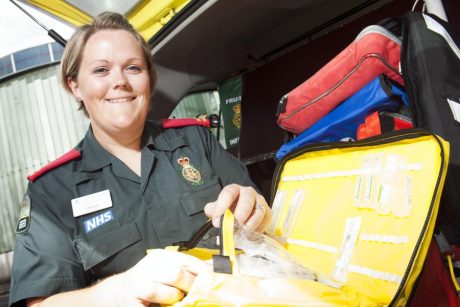Podcaster joins advanced paramedic making life or death decisions
The life or death decision-making of an advanced paramedic at London Ambulance Service is documented in the latest instalment of The Economist’s management podcast.
Chelsey Pike – the first woman ever recruited to the advanced paramedic role – is the latest guest to feature in Boss Class, presented by Andrew Palmer.

Andrew joined Chelsey for a shift and describes how she is faced with a constant barrage of information about new patients with 999 calls coming in from across the capital.
In the show, he says: “She monitors a blizzard of incoming information, she effortlessly picks up cues from her surrounding environment: call logs; snatches of conversation elsewhere in the room that pass me by entirely.
“She investigates several suspected cardiac arrests; she talks to someone who has drilled into a mains cable; she follows the case of a baby who has rolled off a sofa; and keeps track of reports of two people inside a building on fire. The pace is relentless.”
Andrew sat with Chelsey in the Tactical Operations Centre at London Ambulance Service headquarters in Waterloo. He watched her decision-making in real time.
There were five critical care advanced paramedics covering the whole of the city and Chelsey had to decide where to send them.
The pair were sat in front of screens showing emergencies across London. Chelsey relied on her experience and her ability to rapidly digest and respond to incoming information to prioritise calls.
The podcast host described Chelsey as a super computer – quickly analysing and making decisions for the sickest patients in London. The stakes are high.
Pioneering clinical role
Chelsey has been a paramedic in London for 16 years and a critical care advanced paramedic for the last decade, since the introduction of the role.
Critical care advanced paramedics are highly skilled and highly qualified paramedics who are sent to patients with the most life-threatening illnesses or injuries across the capital.
The pioneering clinical role, developed in London, pushed the boundaries for what paramedics can do in the community – including surgical procedures and realigning broken bones.
They are most commonly sent to patients in cardiac arrest or patients with traumatic injuries and their skills and experience provide additional support to ambulance crews at the scene.
When the team was first set up in 2014, there were 12 advanced paramedics. There are now 40, with three clinical supervisors and a clinical development manager.
As well as responding to patients night and day, one advanced paramedic is always on duty in the London Ambulance Service control room listening to 999 calls.
Chelsey said: “We have an opportunity to make a real difference. But with just a handful of advanced paramedics available on every shift, a key part of my job is trying to see where we can make the biggest impact.
“We have a really strong team with amazing clinicians who always endeavour to help Londoners and their families as much as they can.”
Chelsey admits in the podcast how hard she finds it to take breaks when she knows Londoners need her help. But she finds respite in her team.
She said: “For me talking with my colleagues is incredibly helpful to processing the high pressure and difficult outcomes we deal with on a daily basis.”
For the episode, Andrew compares how Chelsey makes her decisions to executives at Starbucks and Levi Strauss. To listen you need to subscribe to The Economist podcast.
Anyone interested in working for London Ambulance Service can find out more on the careers page here.

Follow us on social media: